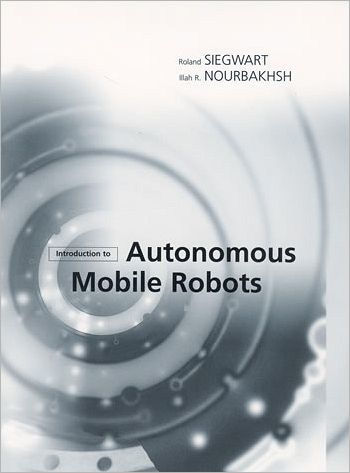This review was originally written for the robots.net blog

MIT Press recently sent their latest book on mobile robotics, Introduction to Autonomous Mobile Robots by Roland Siegwart of EPFL and Illah R. Nourbakhsh of CMU. The book provides a load of useful information on mobile robot locomotion and navigation issues. If you’re struggling with the problem of how to make your robot get from point A to point B quickly and efficiently while avoiding obstacles, this book may have your answer. Read on for the full review.
Introduction to Autonomous Mobile Robots provides a succinct overview of mobile robotics with an emphasis on mobility. After a brief, general introduction to mobile robots, the book proceeds to break down the field into specific topics, such as kinematics, locomotion and navigation. Each topic begins with more summary of the problems faced by mobile robots, then presents the most common solutions or approaches. Almost everything covered by the book is useful and I would definitely recommend this book as an addition to any serious robot builder’s library.
The book almost reads like Cliff Notes for the robotics student. You can quickly pick up most of the current ideas and buzzwords found in the field of robot mobility, without having to read hundreds of pages of dry technical material. Need to know the six types of robot locomotion? See page 14. Want to see a chart of every possible wheel geometry for wheeled robots? See page 34. How about a breakdown of robot sensors by active vs. passive and proprioceptive vs. exteroceptive? See page 91. A list of just about every known obstacle avoidance algorithm? See page 287. Well, you get the idea. There are a couple of curious omissions, however, including a complete lack of information on subsumption (as well as behavioral robotics in general) and BEAM technologies. There is also no discussion of common standardized robot operating systems such as Orocos or Player/Stage. It would have been useful to see a comparison of the technologies and algorithms supported by off-the-shelf software.
The book includes enough detail that it should be easy to understand and implement the strategies described. There are also frequently references to further information on selected topics.
Because the book is aimed at college-level readers, it doesn’t hesitate to present the math associated with the subject when necessary. The technical detail puts this book a notch above the average hobbyist level introductory robotics book. Almost anyone building robots has searched, at one time or another, for an algorithm or formula that can easily be found in this book. For a hobbyist who has built a few simple robots and would like to learn more advanced technologies, this book would make a great introduction to the methods and algorithms being used in university-level mobile robot research institutions like CMU and EPFL.
